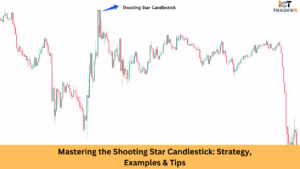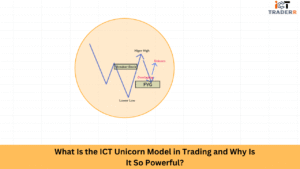The ICT Venom Trading Model has emerged as one of the most powerful price action strategies in modern forex trading. Developed by Michael Huddleston (ICT), this approach helps you identify high-probability setups by understanding smart money manipulation and institutional order flow.
In this comprehensive article, we will walk you through everything you need to know about implementing the Venom model successfully.

What is the ICT Venom Trading Model?
The ICT Venom Model is a price action-based trading strategy derived from the core principles of smart money concepts. It focuses on identifying liquidity grabs, market structure shifts, and order block rejections to pinpoint high-probability trade entries. It is a model that helps enter trades the same way institutional money would, avoiding premature retail trap signals.
Unlike the lagging indicators, the Venom Model is based on price action in real time, emphasizing the need to know where the entry or exit might be made by smart money.
Why Smart Money Uses This Model
Institutional traders—or what’s often referred to as smart money—rely on liquidity to fill large orders. The Venom Trading Model taps into these behaviors by analyzing liquidity zones, inducement levels, and fair value gaps. Here’s why it appeals to smart money:
Precision in Entry: The model offers sniper-like entries near major supply and demand zones.
Liquidity Sweeps: It capitalizes on liquidity runs, where price manipulates levels to trap retail traders.
Market Efficiency: It aligns with how markets truly operate—based on order flow, not indicators.
Understanding and applying this model allows you to anticipate institutional moves and ride the momentum effectively.
How the Venom Model Works (Step-by-Step)
The ICT Venom model follows a systematic approach that can be broken down into clear, actionable steps:
- Identify Liquidity Zones: Look for equal highs/lows, trendlines, or support/resistance where liquidity is resting.
- Wait for Liquidity Sweep: Price should take out these zones—this is often the smart money grabbing orders.
- Observe Market Structure Shift (MSS): A clear break in the previous structure confirms a change in direction.
- Locate the Entry Trigger: Look for a strong order block, FVG (Fair Value Gap), or breaker block.
- Execute With Confluence: Combine the above with session timing and HTF (Higher Timeframe) direction.
Bullish Venom Setup – Buy Trade Example
Let’s examine a practical bullish Venom setup using a real market scenario:
Market Context: EUR/USD on the 1-hour timeframe during the London session.
Setup: Price has been in an uptrend with clear higher highs and higher lows.
The Trade Development: Price approaches a previous swing low where retail traders likely have buy stop losses positioned. Within minutes, price aggressively reverses higher, forming a hammer-like candlestick pattern.
Entry Strategy: Enter long when price returns above the swept low, preferably from a fair value gap or order block. The entry should occur within the first few candles of the reversal to maximize reward potential.
Risk Management: Stop loss: 5-10 pips below the liquidity sweep low. Take profit: Previous swing high or 1:3 risk-reward ratio.
This example demonstrates how the Venom model capitalizes on institutional manipulation while providing clear entry and exit criteria.
Bearish Venom Setup – Sell Trade Example
The bearish Venom setup mirrors the bullish version but targets liquidity above key resistance levels:
Market Context: GBP/USD on the 4-hour timeframe during the New York session.
Setup: Price has been in a downtrend with lower highs and lower lows
The Trade Development: Price rallies toward a previous swing high, where retail traders have placed their sell stop losses. Smart money pushes price 15-20 pips above this level, triggering retail stops and creating temporary buying pressure. However, this move lacks genuine institutional support.
Entry Strategy: Enter short when the price fails to sustain above the swept high and begins reversing lower. Look for entry from order blocks or fair value gaps in premium territory.
Risk Management: Stop loss: 10-15 pips above the liquidity sweep high. Take profit: Previous swing low or measured move target.
This bearish example shows how the Venom model works equally well in both market directions when proper context is considered.
Best Timeframes and Sessions to Use It
For optimal results, the Venom Model should be applied during high-liquidity sessions and specific timeframes:
Timeframes: 5M, 15M, and 1H for entries; 1H and 4H for market context.
Optimal Trading Sessions: The London session (3:00-6:00 AM EST) provides the highest success rate for Venom setups due to increased institutional activity. The New York session (8:00-11:00 AM EST) also offers excellent opportunities, particularly for USD pairs.
Timing is crucial. Always align your entries with session volume and daily bias.
Common Mistakes to Avoid
Even experienced traders can misinterpret the Venom Model. Here are common pitfalls:
- Premature Entry: Many traders enter before confirming the liquidity sweep completion. Wait for clear reversal signals before executing trades.
- Ignoring Market Context: Trading against higher timeframe bias significantly reduces success rates. Always align Venom setups with market structure.
- Poor Risk Management: Placing stops too tight or too wide can destroy profitability. Maintain consistent risk-reward ratios of at least 1:2.
- Overtrading: Not every liquidity sweep creates a valid Venom setup. Be selective and focus on high-probability scenarios with clear institutional fingerprints.
- Lack of Patience: The best Venom setups often require waiting for optimal market conditions. Forcing trades in choppy or low-volume conditions typically leads to losses.
Staying disciplined and patient increases your accuracy dramatically.
How to Find the Perfect Entry Using This Model
The perfect entry occurs when multiple elements of the model align. Here’s what to look for:
HTF Trend Confirmation: Use 4H or 1H to confirm overall bias.
Liquidity Grab & Reversal Candle: A stop hunt followed by rejection is key.
Market Structure Shift: A break in structure confirms intent.
Entry at Order Block or FVG: This provides minimal risk with maximum reward.
Time of Day: Prioritize entries during session opens for momentum.
Conclusion
The ICT Venom Trading Model is a masterclass in smart money price action. When properly applied, it gives very accurate and high-probability trade setups with institutional order flow. By employing liquidity manipulation and market structure against timing, you get to enjoy a very lucrative edge in Forex.
Incorporate this model into your trading plan, and always backtest thoroughly. Once mastered, the Venom Model can become your go-to strategy for consistent profits.
FAQs
Is the ICT Venom Model suitable for beginners?
Yes, but the beginners should study the smart money concepts first and then progress to market structure and liquidity theory.
Can I use the Venom Model in crypto trading?
Absolutely. It works well with volatile crypto assets like BTC and ETH, especially on lower timeframes.
How do I backtest the Venom Model?
Use platforms like TradingView. Replay sessions during the London or New York open, and mark key elements like liquidity zones and order blocks.
Do I need indicators for this model?
The Venom Model, in our view, is based on pure price action and market structure. However, some traders may use volume or session indicators for confluence.



